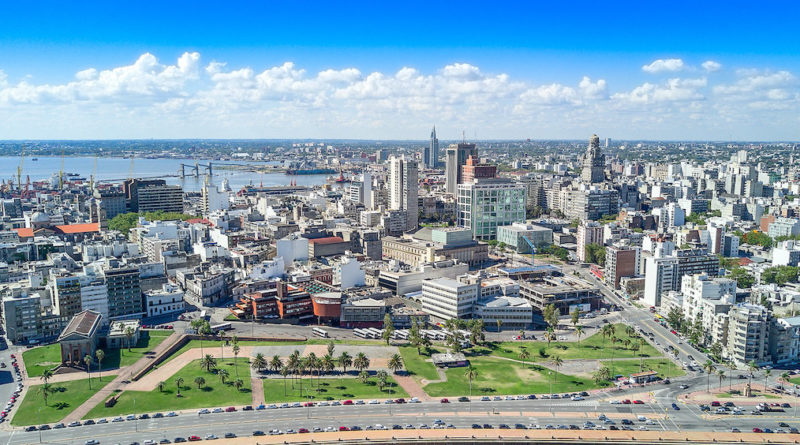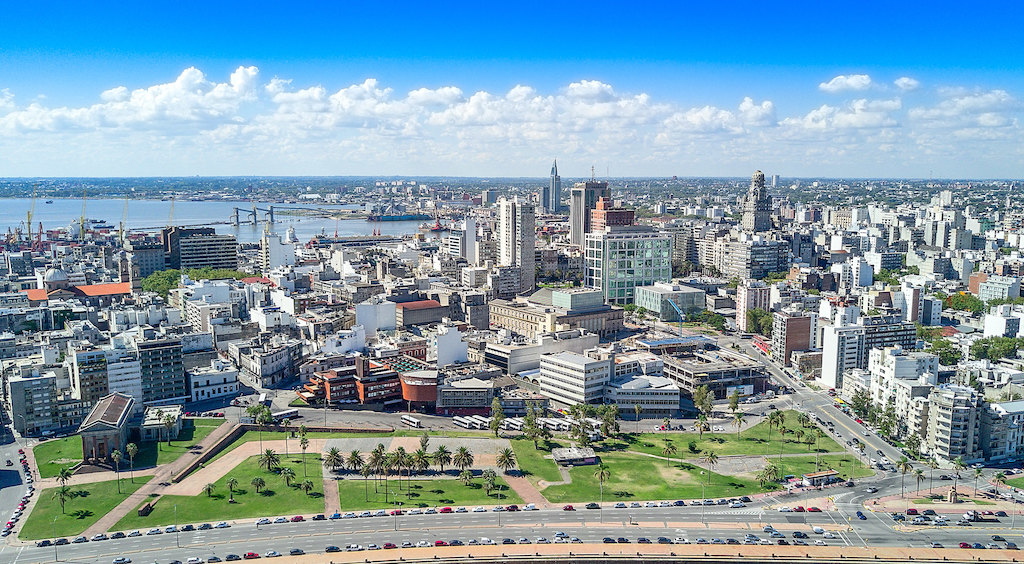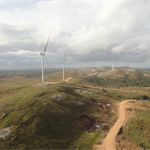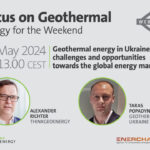Looking at the geothermal opportunities in Uruguay
Energy Disrupter
In this local article, researchers share insights in the areas with potential for geothermal energy utilisation in Uruguay, South America.
In an article published in Geothermics (no. 95, 2021), a group of authors from Uruguay in South America looks into the “Potential of geothermal energy in the onshore sedimentary basins of Uruguay”. The below article provides a translation of an overview shared in La Diaria from Uruguay. Uruguay shares borders with Argentina to its west and southwest and Brazil to its north and northeast; while bordering the Río de la Plata to the south and the Atlantic Ocean to the southeast.
The investigation by the authors reveals three areas of the country where geothermal energy could be utilized, with one sufficiently hot to be used for power generation.
Geothermal? In Uruguay?
In the article, signed by Ethel Morales, Gerardo Veroslavsky, Agostina Pedro, Facundo Plenc, Rodrigo Umpiérrez, Micaela Ferreiro and Manuela Morales, from the Faculty of Sciences of the University of the Republic (Udelar), Alberto Manganelli and Lucía Samaniego de Ceregas (Regional Center for Groundwater Management in Latin America and the Caribbean) and Josefina Marmisolle de Ancap, a case is made to look into geothermal as an option.
The authors point to the knowledge of low temperature geothermal energy in the country, with the tourism sector taping geothermal energy director for recreational and balneological purposes. “The Guaraní Aquifer System has been exploited for more than 50 years.”
The objective of the authors was “to use geological and geophysical data to identify and characterize potential geothermal systems in the three terrestrial sedimentary basins of Uruguay”.
For this, they worked in the three terrestrial sedimentary basins of the country: “the North Paleo-Mesozoic Basin in the north and the Mesozoic Basins of Santa Lucía and Laguna Merín in the south.” And they collected “all available information” that was “dispersed among various national organizations and institutions, scientific articles and technical documents.” So they scrambled, dusted, accessed and scrutinized “reports and databases belonging to the National Agencies of Mining and Geology (Dinamige), Water (Dinagua), Environment (Dinama), Energy (DNE) and Meteorology (Inumet), together with the state oil company (Ancap) and the Regional Center for Groundwater Management of Latin America and the Caribbean (Ceregas) ”. What’s more, they collected their own information through 25 magnetotelluric stations in the North basin and the Laguna Merín basin. By analyzing all this information, the areas of geothermal interest and their future possibilities were outlined.
There has been extensive work on hydrocarbons and there is a clear relationship between hydrocarbons and geothermal: some of the unsuccessful searches for oil ended up finding hot springs, something like a consolation prize that has allowed more sustainable developments for some regions than having found the slimy black gold.
A research project presented to the CSIC was called “Evaluation of the geothermal energy potential in the Salto pilot area (North Basin-Uruguay)”, which in addition to characterizing the Salto region basin, does the same with the Santa Lucía basin and the Laguna Merín basin.
“Deep geothermal systems can be classified into three groups: those of low temperature, those of medium temperature and those of high temperature,” explains Morales, with his patience as a teacher. “We certainly do not have high temperature systems, because that is associated with volcanoes. We do have, in the north, a system that is the Guaraní Aquifer, which is a low-temperature system. It is a classic system, which occurs when there is a water reservoir located at a significant depth. Simply due to the temperature gradient, due to its increase due to depth, the water contained in the reservoir is hot ”. From there they water several of the hot springs on the north coast of the country. But their experience in the work related to the search for hydrocarbons made them think that there could be something more there.
Do not stay with the obvious: the case of Salto
In Salto and surrounding areas there is more geothermal potential than we think. “We propose, because we have characterized the place from the geological point of view and through geophysical analysis, that between Salto and the Termas del Arapey there is also a structural corridor where the basin reaches more important depths,” says Morales.
“With the data we had, we were quite sure that this corridor has a northwest orientation and that it continues towards Argentine territory. But we think that, in addition to the deepening that occurs in that northwesterly direction, there were also other north-south structures that made the basin even deeper, ”he explains, letting us look out on the balcony of the hypotheses that led to the field. “In order to identify that area where it was deepening more, we made some magnetotelluric transects that cut them to be able to confirm that the basin was deepening,” he says.
His work paid off. “We find that area that determines the deepening of the basement and therefore we have a much greater thickness of the basin, and a depth of about 3,500 meters,” says Morales. And before anyone is alarmed by the Guaraní Aquifer, the work points out that “this geothermal system is separated from the Guaraní Aquifer System by more than 600 meters of sedimentary rocks belonging to the Late Carboniferous-Permian mega-sequence.”
Morales remains enthusiastic and points out that this deepest fault is very close to the Uruguay River. “The greatest depth of this basement occurs in Argentine territory, but in our territory we have a depth of about 3,700 meters, which is an adequate depth to have a temperature of at least 95 ° C. That is no longer geothermal energy. low temperature, like hot springs, but medium ”.
“With a temperature of around 95 degrees Celsius, it could be passed to other uses of geothermal energy, such as the generation of electricity. It would be there in the North basin the only area of ??Uruguay in which we envision that this indirect use of geothermal energy could be carried out ”, adds Morales. Just as it is impossible not to think of an elephant after being told “think of anything but an elephant”, once one listens to Morales or reads the article, it is inevitable not to think of a future in which Salto will generate clean electrical energy using the heat from the entrails of the planet. Knowing is also dreaming.
Other northern opportunities
Those deep areas of the North basin could provide water over 95 degrees Celsius to produce electricity with turbines if we move in that direction. However, there is already low-temperature geothermal energy there, such as that of the hot springs, which could contribute to a life that is less harmful to the environment and more independent from the fluctuations in international fuel prices. It is good that we bathe in warm water, that we enjoy relaxing in warm pools, but we can make that heat lead us to look further afield.
“Geothermal energy allows direct uses. But there are others ”, says the researcher. At work Morales and his colleagues are crafty. Depending on the basin studied, they propose some uses that will surely tempt various local actors. In the case of the north coast, they mention in the article the “residential heating and cooling in individual or communal systems, as well as some uses of heating in agricultural operations (for example, greenhouse heating) or industrial (for example, heating in industrial of paper and sugar) “. Morales justifies: “It is that for this energy to be used, several factors have to be combined. We think that Salto has a high development potential because it already has an installed infrastructure and there is a population density that allows it ”.
Attentive, Andrés Lima and other possible future mayors. They even point out in the work that “in some areas, chain uses of geothermal waters would be feasible. For example, hot water could be applied to balneology, greenhouse heating, residences or fish farming, where wastewater can be used for irrigation ”. In other words: make better use of what we already have.
“In Salto, the waste water from the thermal pools could be used, which are currently being discharged into the river water courses,” says Morales. “That energy could be used, for example, by means of a chain system, passing hot water through a greenhouse.” It is a system similar to that of a radiant slab: pipes through which hot water circulates. “There was an experience from a project of the ANII [National Research and Innovation Agency] of colleagues from the Centro Universitario Litoral Norte and they gave good results, for example, in the cultivation of tomatoes. And that result was obtained simply by using the waste water from the hot springs, there were no other perforations, which shows that a more efficient use could be made of the waste water from the hot springs ”, he points out.
Potential at Laguna Merín
The work in the Laguna Merín basin is more speculative, and so they point out: “It has the greatest uncertainties regarding geothermal potential, due to the lack of geological and geophysical data.” But they moved on anyway.
“We had an ANII research project in the Laguna Merín basin, which is the least known in Uruguay because there is no well that has reached its bottom, it was not even known exactly how deep the basement was. So we did a magnetotelluric geophysical study, which is accessible, and we were able to obtain information, “says Morales.
The project presented to the ANII was not focused on geothermal energy. It was called “Preliminary Assessment of the Hydrocarbon Potential of the Laguna Merín Basin.” But since they were there and they managed to get the rocks to speak, they weren’t going to pass up what they could tell about this energy.
“We were delighted with what we got from the basin. We were able to define its geometry its edges. Today we can say that, contrary to what we thought, the basement is not at 4,000 meters but at 2,500. It is a shallow basin ”, he says.
“We found fascinating things. And thinking about geothermal energy, we find bodies with high conductivity at important depths, of about 1,250 meters ”. And while the geothermal potential here doesn’t come from irrefutable direct evidence, what you see allows you to hypothesize. “We know that the basin fill is essentially volcanic, so while these high levels of conductivity can represent several things, they surely correspond to the presence of a liquid phase. So, although we do not know exactly the nature of that which is there, thinking about analogous situations in the North basin, there could be an aquifer with sandstones there. If so, and considering the normal geothermal gradient, at that depth there would be water with a temperature close to 50 ° C ”, says Morales.
In the work they point out that this geothermal energy could have various direct uses: “residential heating and cooling, evaporation of milk, drying of cereals, process heat for dairy industries, cultivation of mushrooms and carbonation of beverages.” As the astute fisherman knows, the bait used is a large part of the success. And in the analyzed basin, rice activity abounds. “We think more than anything about the drying of grains due to the productive activity that exists in that area,” Morales acknowledges, as one who says that carp must be caught using corn with a little dough.
“In the Santa Lucía basin, although there are wells, there are no temperature measurements like there are in the North basin. What we did there was to use all the existing information with a geothermal perspective ”, Morales explains. And all this makes them leave in writing in the work that “geological and geophysical data support the presence of low-temperature geothermal systems within this intracratonic basin.”
“The Santa Lucía basin is a rift basin , that is, it has very marked edges and has a very marked central basement, so there would be water circulation through those structures that would go deep. And simply, due to the geothermal gradient, again, the water would be heated to about 50 ° C ”, he points out. Unlike the Laguna Merín basin, there are wells here. “We know then that there are sandstone bodies with good porosity and permeability that could function perfectly as reservoirs, we have seal rock, which prevents the circulation of fluids, above that reservoir.” For all this, he says that “the stratigraphic and geological configuration shows us that it is highly probable that there, passing 1,200 meters, there is a geothermal reservoir with a temperature of about 50 ° C”.
How could that geothermal energy be used? Again, with direct uses: “In addition to the possibilities associated with residential heating and cooling, various uses are possible in agricultural and industrial processes (evaporation of milk, process heat for textile, paper and dairy industries)”, they say in the article . Again, they embody well: they say that “the territory occupied by the Santa Lucía Basin is strategic for Uruguayan society”, stating that “almost 32% of the rural population is concentrated in this area” and mentioning the different productive activities (horticulture, fruit growing, viticulture, poultry farming, dairy, among others).
And one more chance
“We believe that there is another enormous potential for the use of geothermal energy that could occur throughout the Uruguayan territory,” Morales shoots. My eyes go wide as they would, although I suppose for different reasons, those of a UTE manager and those of a CEO of an oil exporter.
“It is the very low temperature geothermal energy housed by the ground a few meters deep,” he says. “The ground, less than ten meters away, works as if it were ceramic: it stores and maintains heat. During the day the air temperature undergoes variations, but on the ground the temperature remains relatively constant throughout the day and throughout the year ”, he explains.
“This very low temperature geothermal energy can be used to heat homes or to cool if a heat exchanger is used,” he says then. “The temperature of our soil is about 18-19 ° C. So, during the summer, it can be used, because it is more efficient and economical to cool a house to 22 ° C starting from 18 ° C than from 32 ° C, or In winter it is easier to heat, since it is not the same from 5 ° C to 18 ° C. We believe that this has potential ”, he explains.
But it is not something that is completely up in the air. “We did a fairly preliminary but encouraging estimate at Salto. There is a superficial aquifer, formed by sandstones and conglomerates, which has water in its interstices, called the Salto Formation. We made estimates of the geothermal energy potential and the results are encouraging. That water at 19 ° C could be used to heat or cool residences, to obtain hot sanitary water. It is a more restricted use but if we extend it to all residential uses, it could have a significant impact ”, he says. This very low temperature geothermal energy could be explored throughout Uruguay, because it is the heat contained in the most superficial layers, since at 10-15 meters the soil temperature begins to stabilize. And in the country we have many surface aquifers ”, he points out. Once again we clarify: the water could return to the system and at no time are products added that alter its properties. It would only be the vehicle to bring us the heat that is already there a few meters below.
The marked points. And now that?
The research carried out points to areas where there is potential to think of geothermal energy as a possibility. And now? What effort should we make as a country to confirm it? Do we have what it takes?
“Perhaps the first thing we have to do is analyze some water samples and take temperature profiles in wells, something that we had planned with our colleagues at the National Observatory of Brazil for March of last year, but that could not be given because it was when the pandemic began, ”Morales points out. I tell him to pretend that he has more resources. “Thinking bigger, it would be ideal to seismic in the Laguna Merín basin and then see where to drill,” he answers.
“I think that without a doubt this is a field in which we are going to see growing interest in the short term, especially seeing how it has grown elsewhere. There should be an interesting focus of attention, research and work. I think we are going to replicate what has happened in other countries, ”Morales says. Neighbors, mainly Brazil, are already working on this. “We are the ones who are further behind in the region, both in its use and in its study,” he says. “Geothermal energy is a bit relegated in our country for several reasons. And that is even seen in the geology career, where there is no class in some of the disciplines where geothermal energy is discussed. And that carries over to all spheres. I think that starting to look at her is everyone’s responsibility. From the academy, when doing these preliminary studies,
Geothermal energy is there, under our feet. We need to study it. And after a rational and evidence-based evaluation process, we will see if it is feasible or not to use it and if we want to do it or not. But another very different thing is not to use that energy due to ignorance. “This is very important and it also happens with hydrocarbons. Knowing is the main thing. Then comes how it is managed or what priority is given or if the use is discarded for 50 years or forever. But knowing always gives us power, it always helps, ”Morales concludes. The work you just published with your colleagues empowers us and immerses us in a warm optimism that comes from the bowels of the planet.
- Article: “Potential of geothermal energy in the onshore sedimentary basins of Uruguay”
- Publication: Geothermics (no 95, 2021)
- Authors: Ethel Morales, Gerardo Veroslavsky, Alberto Manganelli, Josefina Marmisolle, Agostina Pedro, Lucía Samaniego, Facundo Plenc, Rodrigo Umpiérrez , Micaela Ferreiro, Manuela Morales.
Source: La Diaria Ciencia

















